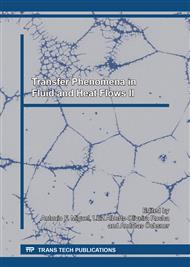[1]
Pannala, S., Syamlal, M., O`Brien, T. J., 2011, Computational Gas-Solid Flows and Reacting Systems: Theory, Methods and Practice. Hersheys – USA. United States of America by Engineering Science Reference.
DOI: 10.4018/978-1-61520-651-3.ch001
Google Scholar
[2]
Lun, C.K.K., Savage, S.B., Jeffrey, D.J., Chepurniy, N. 1984, Kinetic theories for granular flow: inelastic particles in Couette flow and slightly inelastic particles in a general flowfield. Journal of Fluid Mechanics, 140: 223-256.
DOI: 10.1017/s0022112084000586
Google Scholar
[3]
Agrawal, K., Loezos, P.N., Syamlal, M., Sundaresan, S. 2001, The role of meso-scale structures in rapid gas-solid flows. Journal of Fluid Mechanics, 445, pp.151-185.
DOI: 10.1017/s0022112001005663
Google Scholar
[4]
Gidaspow, D. 1994, Multiphase Flow and Fluidization – Continuum and Kinetic Theory Descriptions. Ed. Academic Press, London, 467 p.
DOI: 10.1002/aic.690420438
Google Scholar
[5]
Syamlal, M., O'Brien, T.J. 1987, A Generalized drag correlation for multiparticle systems. Morgantown Energy Technology Center DOE Report.
Google Scholar
[6]
Taghipour, F., Ellis, N., Wong, C. 2005, Experimental and computational study of gas–solid fluidized bed hydrodynamics. Chemical Engineering Science, 60: 6857–6867.
DOI: 10.1016/j.ces.2005.05.044
Google Scholar
[7]
Benyahia, S., Syamlal, M, O. Brien, T.J. 2006, Extension of Hill Koch Ladd drag correlation over all ranges of Reynolds number and solids volume fractions. Powder Technology, 162: 166-174.
DOI: 10.1016/j.powtec.2005.12.014
Google Scholar
[8]
Li, J., & Kwauk, M. 1994, Particle–fluid two-phase flow: The energy-minimization multi-scale method. Beijing: Metallurgical Industry Press.
Google Scholar
[9]
Li, J., Tung, Y., & Kwauk, M. 1988, Energy transport and regime transition of particle–fluid two-phase flow. In P. Basu, & J. F. Large (Eds. ), Circulating fluidized bed technology II (p.75–87). Oxford: Pergamon Press.
DOI: 10.1016/b978-0-08-036225-0.50012-5
Google Scholar
[10]
Li, J., & Kwauk, M. 2003, Exploring complex systems in chemical engineering—The multi-scale methodology. Chemical Engineering Science, 58, 521–535.
DOI: 10.1016/s0009-2509(02)00577-8
Google Scholar
[11]
Shi, Z., Wang, W., Li, J., 2011, Bubble-Based Emms Model For Gas–Solid Bubbling Fluidization, Chemical Engineering Science, vol. 66, no. 22, pp.5541-5555.
DOI: 10.1016/j.ces.2011.07.020
Google Scholar
[12]
Geldart, D., 1973, Types of gas fluidization. Powder Technology, V. 7, 285-292.
DOI: 10.1016/0032-5910(73)80037-3
Google Scholar
[13]
J. Li et al., From Multiscale Modeling to Meso-Science, DOI: 10. 1007/978-3-642-35189-1_1, Springer-Verlag Berlin Heidelberg (2013).
Google Scholar
[14]
Ergun, S., 1952, Fluid flow through packed columns, Chemical Engineering Progress, vol 48, p.90–98.
Google Scholar
[15]
Zenit, R., Hunt M.L., 2000, Solid fraction fluctuations in solid–liquid flows. International Journal of Multiphase Flow, vol. 26, p.763–781.
DOI: 10.1016/s0301-9322(99)00066-x
Google Scholar
[16]
Zhang, D. Z., VanderHeyden, W. B., 2002, The Effects Of Mesoscale Structures On The Macroscopic Momentum Equations For Two-Phase Flows. International Journal of Multiphase Flow, vol. 28, p.805–822.
DOI: 10.1016/s0301-9322(02)00005-8
Google Scholar
[17]
Wen, C. Y., Yu, Y. H., 1966, A Generalized Method For Predict Minimum Fluidization Velocity. AIChE Journal, vol. 12, n. 3, pp.610-612.
DOI: 10.1002/aic.690120343
Google Scholar


